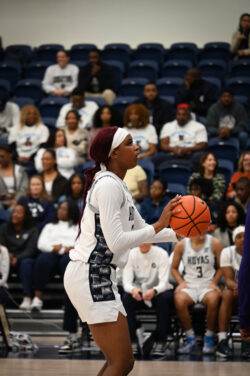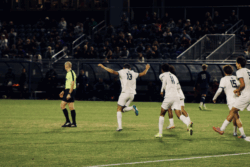For years, HoyaSaxa.com has been the holy grail of information for fans of Georgetown football and basketball. Of course, there is no lack of internet sources for Hoya basketball, but site editor John Reagan (MSB ’84) provides the most comprehensive coverage of the football program around. Scroll down the page a little bit and you will find a counter, one that today reads: “It has been 2343 days since construction was halted on the Multi-Sport Facility. Give our students a home that befits Georgetown.”
Reagan, like most Hoya football diehards, sees the problems with the program – starting with the glaring unfinished field that sits in the heart of campus. Now, well over six years after construction on MSF came to a halt, Georgetown’s athletic priority has shifted to the new Intercollegiate Athletics Center.
The Georgetown football team plays at an extreme disadvantage not only due to their home field, but also the team’s operating budget, which is estimated to be about half of what other Patriot League schools are granted. Additionally, much of that budget comes from the tireless efforts of alumni and parents in the Gridiron Club, who bridge the annual gap between actual operating costs and the University’s budget for the team.
The Patriot League’s recent announcement that it will allow merit-based scholarships for football players beginning in 2013 puts Georgetown in another murky situation, one that could ultimately make the school’s disadvantage too drastic to overcome. Coupled with the seemingly daily changes to the Big East conference, Georgetown athletics faces perhaps its most difficult and unclear era. However, for the football program, that could signal the restart of continued progress.
Last summer, President John DeGioia said that moving to a scholarship program would not “fit the ethos and culture of Georgetown,” so seeing the Hoyas follow the rest of the Patriot League and give out 15 scholarships in 2013 does not seem at all plausible. However, it may provide a reality check for the administration that college football, even at the I-AA level, is moving toward scholarship aid.
Reagan, for one, remains an optimist in the program going forward. “Money alone doesn’t win games,” he wrote in an email to the Voice. “Football has repeatedly adapted to changing times at Georgetown since it was founded in 1874, and will continue to do so.”
As for what’s next, there are a number of possibilities. Rest assured that DeGioia will perform his duty, as he did when he added Georgetown to the fledgling Patriot League in 2000. The conference remains a viable option, with a number of respectable institutions, simple travel logistics, and an automatic bid to the FCS playoffs. Non-scholarship conferences are now fairly rare and often present logistical nightmares—take the Pioneer League, comprised of teams from San Diego to Jacksonville, as the prime example.
Given the Hoyas’ typical schedule of Patriot League matchups combined with a couple of regional teams and a couple of Ivy Leaguers, a move to football independence could, in theory, logistically work. That move, however, would be a backbreaker for the program—it could no longer pursue an FCS playoff bid unless the team somehow dominated all of its competition in a single season.
It goes without saying that the Hoyas will never be a I-A, football powerhouse. They would need a few wealthy alumni to throw all kinds of money at the program. But at the end of the day, that’s fine. As Reagan explains, Georgetown student-athletes come to the Hilltop for a “world-class education and the opportunity to compete.” Players pour their hearts and souls into competing for the Blue and Gray, evidenced primarily by their incredible turnaround this season. That effort should come with some merit-based aid, a measure Georgetown will eventually have to adopt once the exclusively need-based aid route becomes a footnote in I-AA history.
But for now, Georgetown will remain in the Patriot League. The administration may not decide either way until the 2012 season is over, as that growing disadvantage between the Hoyas and their competition builds. As we saw last season, and as Reagan pointed out, it’s not just about money or resources. The Hoyas went 8-3 and were on the cusp of a conference title, despite the odds against them. They will remain a force in the Patriot League this season as well. For now, the players and coaches mark the program’s success, and the administration’s impending decision will play a pivotal role in football’s continued footprint on the Hilltop. One day, we may look back on the Patriot League’s recent rule-change as the start of significant progress for Georgetown football, forcing the program to look past the status quo.




